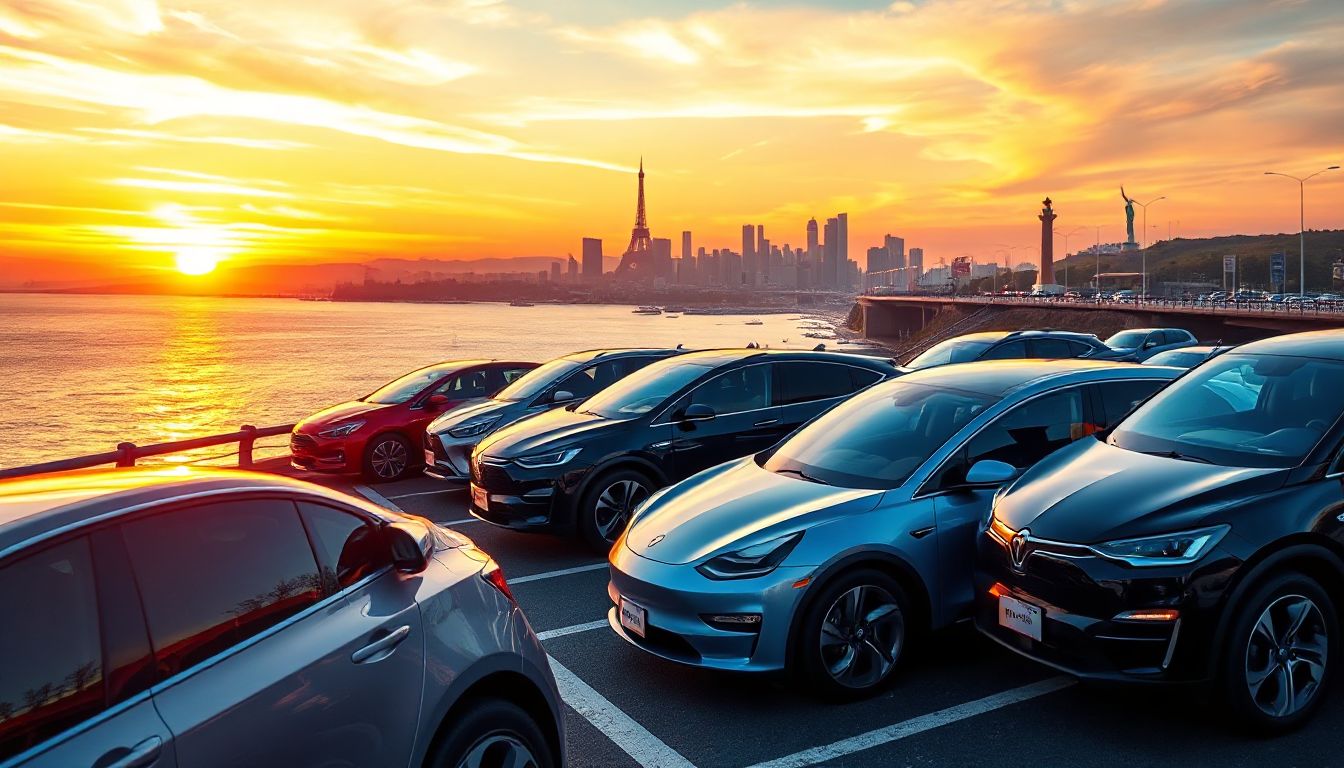Introduction
The rise of electric vehicles (EVs) is changing how we think about transportation. Countries across the world are embracing cleaner, more efficient ways to get around. This shift isn’t just a trend; it’s a vital move toward reducing pollution and fighting climate change. Governments and automakers are setting ambitious targets to cut emissions and push EVs into the mainstream. Understanding how different countries approach this transition reveals which markets are ready to lead and where challenges lie ahead. It’s a story of innovation, policy, and determination shaping a greener future for everyone.
Electric Vehicle Adoption by Country: An Overview
Global EV Market Trends
Over the last few years, EV sales have skyrocketed worldwide. More people are choosing electric cars instead of traditional gas-powered vehicles. China, Europe, and North America now own the biggest shares of the market. China alone accounts for nearly half of all EV sales, signaling its leadership role. Meanwhile, Europe sees rapid growth thanks to strong policies, and the US continues to expand with big automakers shifting gears. This global growth highlights how electric vehicles are no longer a niche but a key part of modern transport.
Factors Influencing Adoption Rates
Several things shape how quickly EVs catch on in different countries. Infrastructure is a major factor—more charging stations make EVs easier to own. Government policies like tax breaks and subsidies boost sales significantly. Consumer awareness also matters—people need to know EVs are reliable and affordable. Economic conditions, fuel prices, and public attitudes influence what choices shoppers make. When these factors align, EV adoption accelerates, making cleaner transport a reality.
Leading Countries in Electric Vehicle Adoption
China: The Global Leader in EV Market Share
China dominates the EV scene with the largest market and most sales. In 2022, Chinese EV sales hit over 3.3 million units, making it the world’s largest EV market. The government plays a big role through generous subsidies and strict targets for automakers to produce electric cars. Companies like BYD, NIO, and Xpeng lead the charge. China’s infrastructure is rapidly expanding too, with thousands of charging stations connecting major cities. All this makes China a powerhouse for EV growth, setting an example for others to follow.
European Union: Pioneering EV Policy and Market Expansion
Europe is known for pushing tough emission rules. Countries like Norway, the Netherlands, and Germany lead in EV adoption. Norway stands out with over 80% of new car sales being electric. Policies such as tax incentives, free parking, and low or zero emissions zones encourage people to switch. Though progress is fast, EU-wide adoption faces hurdles like high vehicle costs and limited charging options in some areas. Still, Europe’s commitment to green transport keeps it at the forefront of electric vehicle progress.
United States: Market Dynamics and Policy Variability
In the US, EV growth varies state by state. California is the leader, with nearly half of all EV sales. The federal government offers tax credits, but some states have their own incentives too. Automakers like Tesla, Ford, and General Motors are investing heavily to produce more electric models. However, gaps in charging stations remain a challenge. Despite obstacles, the US shows strong signs of a shift—more electric pickups and SUVs are hitting roads every year, hinting at a cleaner future.
Japan: Innovation and Focus on Hybrid and Full EV
Japan is known for its tech prowess and innovation in batteries and electric cars. Nissan’s Leaf was one of the first affordable EVs, and Toyota continues to be a leader with hybrids. Japanese policies encourage electric and hybrid car purchases through incentives and stricter emission standards. Companies are investing heavily in battery research and new tech, making Japan a top player in EV technology and a key innovator in the industry.
Emerging Countries and Market Growth Opportunities
India: Rapid Economic Growth and EV Potential
India’s EV market is still small but growing fast. The government launched the FAME scheme to boost electric mobility, with plans to make EVs cheaper and more accessible. India’s vast population and rising incomes mean huge potential. Charging infrastructure remains limited but is expanding with new investments. As more affordable EV models arrive, India could become a major player in the global EV scene.
Southeast Asia: Market Expansion and Regional Trends
In Thailand, Indonesia, and Singapore, EV adoption is beginning to pick up. Governments are offering incentives, and automakers are investing in local factories. These countries aim to cut pollution and reduce dependence on imported fuel. While adoption is still in early stages, regional trends suggest a growing market, especially as battery prices drop and technology improves.
Latin America: Increasing Adoption and Market Challenges
Brazil, Chile, and Argentina are seeing more interest in EVs, but hurdles remain. High import taxes, limited charging stations, and high vehicle costs slow growth. Still, policies like tax incentives and plans for more charging infrastructure are signs of change. As awareness rises and infrastructure improves, the region could see faster EV adoption in the coming years.
Policy and Infrastructure Impact on EV Market Growth
Government Incentives and Regulatory Frameworks
Policies matter most when it comes to EV uptake. Tax breaks, direct subsidies, and registration discounts make EVs more affordable. Many countries are also banning new internal combustion engine sales in the future, pushing automakers to go electric. Strong regulations encourage innovation and faster adoption, shaping a market that favors cleaner options.
Charging Infrastructure Development
Without enough charging stations, EVs can’t really reach their full potential. Spreading out charging options—public stations, workplace chargers, and home charging—makes EV ownership easier. Countries like Norway and China have done a great job installing thousands of chargers, making electric cars more practical for daily use. Building this network will be vital for future growth.
Future Policy Trends and Their Global Impact
As governments set net-zero targets, stricter regulations and newer incentives are expected worldwide. International cooperation on battery recycling and technology sharing could accelerate EV development. Policies that support innovation, infrastructure, and consumer awareness will drive the market forward—faster than ever before.
Challenges and Opportunities in the Global Electric Vehicle Market
Supply Chain and Battery Technology
Batteries are the heart of EVs, but sourcing materials like lithium and cobalt can be tricky. Shortages and high prices limit growth. However, advances in battery tech and recycling methods are making EVs more sustainable and cheaper. Better supply chain management is key to scaling up production.
Market Barriers
High upfront costs remain a major barrier for many consumers. Some still doubt whether EVs are reliable or worth the money. Insufficient charging stations also scare potential buyers away. Addressing these issues through better technology and policies is crucial to break down barriers.
Opportunities for Growth
Tech improvements like faster-charging batteries and cheaper materials can open new doors. Partnerships between automakers and energy companies can accelerate infrastructure buildout. As awareness about climate change grows, more people want cleaner, greener cars. These trends create big opportunities to grow EV markets worldwide.
Conclusion
Every country approaches the electric vehicle revolution differently. Factors like policies, infrastructure, and technology decide how fast adoption happens. Leaders like China and Norway show what’s possible when governments and industries work together. But challenges like supply chain issues and high costs still slow progress. To keep pushing forward, governments and companies need to join forces in making EVs more affordable, accessible, and convenient. Shared efforts will make electric cars a true global force, helping us move toward a cleaner planet. If policymakers focus on incentives, build better infrastructure, and educate consumers, EVs will become the smart, everyday choice for millions worldwide.




